The advance could help scientists create new AI-powered algorithms to perform rapid, in-depth analysis of the millions of wildlife images uploaded to the internet by members of the public each year.
These could help reveal key insights into the impacts of climate change, pollution, habitat loss and other pressures on tens of thousands of animal and plant species, researchers say.
Rich resource
Citizen science websites are a potentially rich source of information on how animals and plants are responding to climate change.
However, while existing AI algorithms can automatically identify species in uploaded images, it was unclear if they could reveal other information too.
Now, an international team of scientists has created a new tool to test how well AI algorithms can mine image banks for other information.
This could include details such as what species are eating, how healthy they are, and with which other species they are interacting.
Image tool
The tool – called INQUIRE – measures AI’s ability to drawn conclusions from an image bank of five million wildlife photos uploaded to the iNaturalist citizen science website.
The team found that current AI algorithms are capable of answering some of these types of questions, but they fail on the more complex ones.
These included those that require reasoning about small features within images and ones that contain detailed scientific terminology.
The findings highlight opportunities to develop new AI algorithms that can better help scientists efficiently explore vast image collections, the team says.


